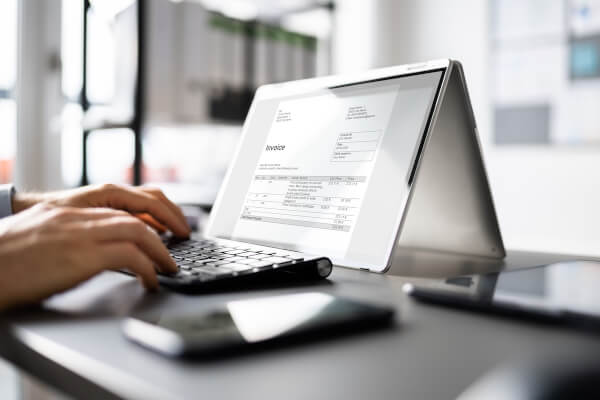How to Hire Independent Contractors in Mexico | Legal Guide & Best Practices
Learn how to hire and pay independent contractors in Mexico. This article also includes an FAQ and best practices about working with contractors in Mexico.

Many small businesses may wonder how to invoice international clients. The process can be more complex than invoicing local customers.
You need to consider the payment terms, type of currency used, and how to send the invoice.
This article will cover all you need to know when invoicing international clients.
| Table of Contents |
|---|
Free invoicing tool from Wise:
Generate and send international invoices
An international invoice is any invoice you send to a client from another country.
These invoices may have different information depending on your client. You may need to include a value-added tax and specify the currency. Both of these factors may differ based on where your international clients are based.
If you want to create an international invoice, you can follow these steps:
International invoices can be more complex than regular invoices. Both parties need to determine a convenient payment method and agree on a currency. Some clients may prefer to use their home country’s currency.
| You can also read our guides on how to write invoices and invoice payments terms for more information. |
|---|
Most small businesses should use E-invoicing.
Small businesses may find that they can benefit from using E-invoicing to send international invoices. This method is often faster and more convenient than sending invoices manually.
Mailing invoices to clients can be time-consuming and can lead to errors or late payments if the mail is lost.
Using E-invoicing also makes it easy to keep track of your invoices in the future. A 2017 Bilentis Study found that companies could save up to 80% of the cost of invoices if they use E-invoices.2 Databridge research predicts that electronic invoicing will grow at a CAGR of 25.4% through 2029.1
There are many things to consider when invoicing international clients. The main issues for international invoices include the currency and local taxes. There are also sometimes hidden fees when you receive international invoice payments.
One of the most essential things to consider in an international invoice is what currency you will use. Most companies will prefer a currency that has had a stable performance. Countries with unstable or regulated currencies may prefer using Euros or US dollars.
According to the IMF3, the share of Euros and US dollars used in invoicing has increased, even as their share in global trade has declined.
For overseas businesses, US dollar transactions can sometimes be quoted at a slight premium.4 This to avoid potential foreign exchange losses.
However, it’s also important to consider the client's needs. Clients may prefer invoices based in their local currency. Doing this can help avoid foreign exchange losses on their end. If they send payments in other currencies, the business may also need to wait several days to receive funds.
The payment method you offer can make a big difference in how fast you’ll receive the invoice payment.
Common invoice payment methods include:
Offering local payment methods can help speed up the payment for international clients. Some countries may be more accustomed to paying by wire transfer, rather than check, for example.
There are some banks that can provide convenient options for receiving international invoice payments. For example, setting up a local bank account may result in lower transaction fees. You may only be able to do this in person, however.
If you invoice international clients from more distant countries, such as India or Australia, it may be best to see if there are any banks that are present in both countries. These banks can make it easier to open local account details.
If you need to receive more than one currency, then setting up local account details for each can be a hassle, however. And it may not even be possible to set up local account details from abroad.
You can use an online banking alternative, such as Wise Business, to set up local account details all in one place. With Wise, you can get details such as a UK account number and sort code, and Euro IBAN, even as a US citizen.
| Read the guide on how to pay invoices to discover more invoice payment methods |
|---|
It is also important to consider international taxes if you use international invoices. Business based in the UK may have to pay a value-added tax (VAT) if their client is overseas, for example.
Many countries in the European Union have a VAT that exceeds 20%.5 Business selling to these EU states may need to add VAT to their invoices. It is crucial to look into this beforehand if you have international clients.
It’s good practice for all businesses to keep track of invoices from previous years. Having these records can help if you need the information for tax audits, or any other reason.
One benefit of using E-invoicing is that it is easier to keep track of all the invoices you have paid.
Another way to help you stay organized is to use the same company for E-invoicing. The company’s software will store these invoices for you. Having this information could be helpful if you need it for an audit.
| Looking for invoicing software? You can find the best invoicing software options in the full guide from Wise. |
|---|
It can be difficult to invoice international clients for free. Popular companies like PayPal can charge a fee for business owners who invoice international clients. PayPal does not charge you to send the invoice, but you have to pay a fee once you receive the funds.
Some companies may offer appealing terms like no fee transactions. However, these companies often use a less favorable exchange rate. You may pay more for the transaction if the company does not use the mid-market rate.
Some businesses may open an account in another country to avoid these fees. Opening a foreign bank account is a good option if it is not difficult to open an account in the country. Moreover, it may be time-consuming to open accounts in some countries if you are not a resident.
Wise is not a bank, but a smart online alternative to traditional banks, designed with international transactions in mind.
The Wise Business account has low, transparent fees and provides the real mid-market exchange rate. You can receive payments to ten local account details, all in one place. This means customers can pay in currencies such as British pounds, Euros, Canadian dollars, and Australian dollars just like they would pay a local business.
This can make it easier for your international customers to pay invoices, which can get you paid faster.
Get international invoice payments
on time with Wise
You’ll also get other useful free tools, such as an invoice generator to create professional invoices for international clients. Moreover, you can save time and energy by connecting to accounting software, such as QuickBooks and Xero.
Open a Wise Business account online with ease, and see how your business can save time, money, and a few gray hairs when it comes to international transactions.
| 💡 For all you need to know about invoices, don't forget to read and bookmark the ultimate guide to invoicing from Wise! |
|---|
Sources:
All sources checked May 23, 2023.
*Please see terms of use and product availability for your region or visit Wise fees and pricing for the most up to date pricing and fee information.
This publication is provided for general information purposes and does not constitute legal, tax or other professional advice from Wise Payments Limited or its subsidiaries and its affiliates, and it is not intended as a substitute for obtaining advice from a financial advisor or any other professional.
We make no representations, warranties or guarantees, whether expressed or implied, that the content in the publication is accurate, complete or up to date.

Learn how to hire and pay independent contractors in Mexico. This article also includes an FAQ and best practices about working with contractors in Mexico.

Learn how to navigate the overseas worker recruitment. Discover legal requirements, sourcing strategies, visa compliance, and tips for international hiring.

Paying overseas vendors is common, but the hidden costs of B2B cross-border payments aren’t. Learn how to simplify international business payments today.

B2B payment processing doesn’t have to be hard. Learn how growing businesses can simplify cross-border transactions, streamline invoicing and get paid faster.

Discover strategies to enhance B2B payment security, reduce fraud risk, and protect cash flow using secure digital payment methods and automated workflows.

B2B payment automation helps small businesses save time and reduce costs. Read about how automation replaces manual tasks and boosts accuracy and cash flow.